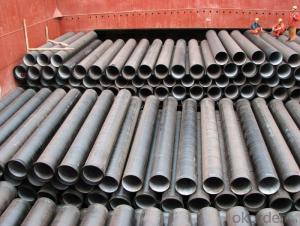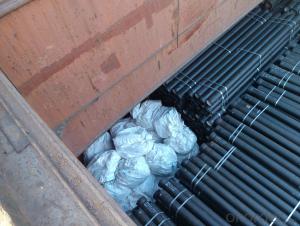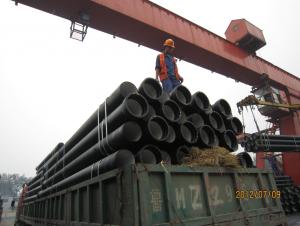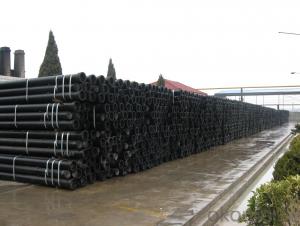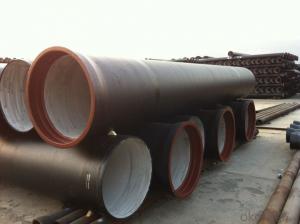DUCTILE IRON PIPE DN600 K8
- Loading Port:
- China Main Port
- Payment Terms:
- TT OR LC
- Min Order Qty:
- -
- Supply Capability:
- -
OKorder Service Pledge
OKorder Financial Service
You Might Also Like
Specification:
1) The standard of pipe: ISO2531:1998, K9
2) Effective length: 6m
3) Inner cement line: Portland cement line as per ISO4179
4) Zinc coating: at least 130g/m2 as per ISO8179
5) Bitumen painting: at least 70um as per ISO8179
6) With 100% quantity of NBR ring, or SBR ring, or EPDM ring as per ISO4633
7) DN80mm-800mm
8) High strength, lighter than grey iron, good corrosion resistance, no furring, small flow resistance, easy fixing, long life tome about 100 yeas
9) Produced by Hangzhou chunfeng machine
10) Checked by automatic inspection equipment
11) Composition:
Chemical composition | | | | |||
Chemical composition | Ductile Cast Iron Pipe (%) | Grey iron pipe (%) | Steel pipe (%) | | | |
C | 3.5-4.0 | 3.2-3.8 | 0.1-0.2 | | | |
Si | 1.9-2.6 | 1.4-2.2 | 0.15-0.4 | | | |
Mn | 0.15-0.45 | 0.4-0.6 | 0.3-0.6 | | | |
P | ≤0.06 | ≤0.3 | 0.02-0.03 | | | |
S | ≤0.02 | ≤0.1 | 0.02-0.03 | | | |
Mg | 0.03-0.06 |
|
| | | |
12) Feature:
Mechanical properties | | | | |||
| Ductile Cast Iron Pipe | Grey Iron Pipe | Steel Pipe | | | |
Tensile Strength(Mpa) | ≥420 | 150-260 | ≥400 | | | |
Yield Strength(Mpa) | ≥300 | No Confirmation | No Confirmation | | | |
Bending Strength(Mpa) | ≥590 | 200-360 | ≥400 | | | |
Elongation (%) | ≥10 | Neglected | ≥18 | | | |
Brinell Hardness(HBS) | ≤230 | ≤230 | About 140 | | | |
13) T type mechanical joint
14) Packing: in bulk or container
- Q:How are ductile iron pipes restrained against axial thrust forces?
- Axial thrust forces are effectively restrained in ductile iron pipes by utilizing both mechanical restraints and soil resistance. A commonly employed method involves the use of thrust blocks, which are concrete structures constructed at bends, tees, and other directional changes in the pipeline. These blocks are specifically designed to withstand axial forces and prevent any shifting or movement of the pipes caused by the pressure exerted by the flowing fluid. Furthermore, additional support and prevention of axial movement are achieved through the implementation of mechanical restraints, such as pipe restraints, thrust collars, and anchor blocks. Pipe restraints are devices installed around the pipe and connected to adjacent structures, such as walls or concrete collars, in order to prevent any sort of movement. Thrust collars, on the other hand, are utilized to absorb and distribute the thrust forces generated by the flowing fluid. These collars, typically made of ductile iron or steel, are securely fastened around the pipe to counteract axial movement. Moreover, soil resistance plays a crucial role in restraining axial thrust forces. The weight of the soil surrounding the pipe creates frictional resistance, which effectively counteracts the axial forces. In order to ensure effective soil resistance, it is vital to properly backfill the trench, compact the soil, and adequately embed the pipe in the soil. In conclusion, a comprehensive approach involving the use of mechanical restraints such as thrust blocks, pipe restraints, and thrust collars, along with the soil resistance provided by proper trench backfilling and compaction, is employed to restrain axial thrust forces in ductile iron pipes. This approach guarantees the secure placement of the pipes and their ability to withstand the axial forces exerted by the flowing fluid.
- Q:Can ductile iron pipes be used for stormwater drainage systems?
- Indeed, stormwater drainage systems can utilize ductile iron pipes. These pipes are renowned for their strength, durability, and resistance to corrosion, rendering them appropriate for various applications, including stormwater drainage. They possess the capacity to accommodate substantial water flow and endure heavy traffic loads, making them a reliable selection for stormwater management. Moreover, ductile iron pipes exhibit exceptional joint performance, guaranteeing a watertight and secure connection, a critical aspect in preventing leaks and preserving the integrity of the stormwater drainage system. All in all, due to their sturdiness, longevity, and ability to withstand the challenging conditions typically associated with stormwater management, ductile iron pipes present a viable choice for stormwater drainage systems.
- Q:How are ductile iron pipes protected against external damage?
- Ductile iron pipes are protected against external damage through a variety of methods. One common method is the application of a protective coating to the pipe's exterior surface. This coating acts as a barrier, shielding the pipe from corrosive elements in the surrounding environment. Additionally, ductile iron pipes can be encased in concrete or a protective sleeve to provide further protection against external damage, such as impact or abrasion. Regular inspections and maintenance are also essential to identify any potential issues and ensure the ongoing protection of ductile iron pipes.
- Q:What are the advantages of using ductile iron pipes?
- Using ductile iron pipes in various applications offers several advantages. To begin with, ductile iron pipes possess a high strength-to-weight ratio, making them a cost-effective option for transporting fluids or gases. They can endure high internal and external pressures, ensuring the dependable and efficient transportation of materials. Furthermore, ductile iron pipes exhibit exceptional corrosion resistance. They are impervious to rust and other forms of corrosion, expanding their lifespan and reducing maintenance expenses. This makes them suitable for underground and underwater applications where corrosive elements are present. Moreover, ductile iron pipes demonstrate superior ductility, enabling them to withstand heavy external loads and impacts without cracking or breaking. This renders them less vulnerable to damage during installation or exposure to harsh environmental conditions. In addition, ductile iron pipes possess excellent flow characteristics. Their smooth inner surface minimizes friction and pressure losses, resulting in efficient fluid flow and reduced pumping costs. This is particularly advantageous in applications requiring high flow rates or long-distance transportation. Additionally, ductile iron pipes are environmentally friendly. They are produced from recycled materials and can be recycled themselves, reducing the demand for raw materials and minimizing environmental impact. Furthermore, their prolonged service life diminishes the need for frequent replacements, further reducing waste generation. Lastly, ductile iron pipes offer versatile installation options. They can be installed using various techniques like trenchless methods, which minimize disruption to the surrounding environment and lower installation costs. Their adaptability and ease of installation make them a preferred choice for various construction projects. Overall, the benefits of utilizing ductile iron pipes encompass their high strength, corrosion resistance, ductility, flow characteristics, environmental friendliness, and versatile installation options. These factors establish them as a reliable and cost-effective choice for numerous applications in various industries.
- Q:Are ductile iron pipes suitable for use in wastewater pumping stations?
- Indeed, in wastewater pumping stations, ductile iron pipes exhibit suitability. Ductile iron, a resilient and robust substance, possesses the capacity to endure the demanding circumstances and corrosive properties of wastewater. With its exceptional resistance to corrosion and ability to withstand high-pressure settings, ductile iron pipes represent an optimal selection for the conveyance of wastewater within pumping stations. Notably, these pipes boast an extended lifespan and necessitate minimal maintenance, thereby reducing operational expenses and guaranteeing dependable and effective wastewater transportation.
- Q:Do ductile iron pipes require concrete encasement for support?
- Yes, ductile iron pipes typically require concrete encasement for support. Concrete encasement provides additional stability and strength to the pipes, preventing them from shifting or collapsing under pressure. It helps distribute the load evenly along the length of the pipe and protects it from external forces such as soil movement or heavy vehicle traffic. Concrete encasement also helps to minimize the risk of damage due to corrosion or external impacts, ensuring the longevity and durability of the ductile iron pipes.
- Q:Will the quality of ductile iron shrink?
- Fool you. It is normal that the surface shrinks and goes down, but it can not be said to be good.
- Q:What effect does magnesium play in nodular cast iron?
- Magnesium can be graphite precipitated in spherical form.But the specific mechanism is not clear, and now it is still debated in the academic circles.In addition, magnesium and sulfur generate MgS, which removes S from molten iron, which impedes the formation of spheroidal graphite.Therefore, Mg has two functions to eliminate the influence of S on Nodular Iron and promote the precipitation of graphite in spherical form.
- Q:Can ductile iron pipes be used for cooling water systems?
- Indeed, cooling water systems can utilize ductile iron pipes. Renowned for their resilience, robustness, and resistance to corrosion, ductile iron pipes are a fitting choice for various applications, including cooling water systems. With the ability to withstand high pressure and temperature fluctuations, these pipes excel in circulating and transporting cooling water. Moreover, their smooth interior surface mitigates friction, diminishing the likelihood of scaling or blockages and enabling the efficient flow of cooling water. Consequently, ductile iron pipes emerge as a dependable and efficient option for cooling water systems.
- Q:Can ductile iron pipes be used for mining applications?
- Yes, ductile iron pipes can be used for mining applications. Ductile iron pipes possess excellent mechanical properties, such as high tensile strength, impact resistance, and durability, making them suitable for various demanding environments, including mining operations. These pipes can withstand heavy loads and pressures, making them ideal for transporting water, slurry, and other fluids used in mining processes. Additionally, ductile iron pipes have a smooth internal surface, minimizing friction and facilitating efficient flow of materials. Hence, they are widely used in applications such as dewatering, tailings disposal, and transporting corrosive or abrasive materials in the mining industry. Overall, ductile iron pipes are a reliable and cost-effective choice for mining applications due to their strength, durability, and suitability for demanding conditions.
1. Manufacturer Overview |
|
|---|---|
| Location | |
| Year Established | |
| Annual Output Value | |
| Main Markets | |
| Company Certifications | |
2. Manufacturer Certificates |
|
|---|---|
| a) Certification Name | |
| Range | |
| Reference | |
| Validity Period | |
3. Manufacturer Capability |
|
|---|---|
| a)Trade Capacity | |
| Nearest Port | |
| Export Percentage | |
| No.of Employees in Trade Department | |
| Language Spoken: | |
| b)Factory Information | |
| Factory Size: | |
| No. of Production Lines | |
| Contract Manufacturing | |
| Product Price Range | |
Send your message to us
DUCTILE IRON PIPE DN600 K8
- Loading Port:
- China Main Port
- Payment Terms:
- TT OR LC
- Min Order Qty:
- -
- Supply Capability:
- -
OKorder Service Pledge
OKorder Financial Service
Similar products
New products
Hot products
Hot Searches
Related keywords
